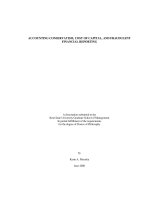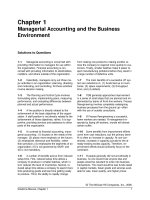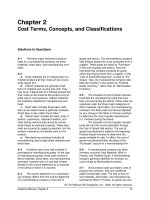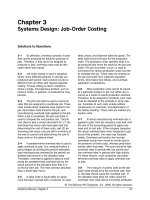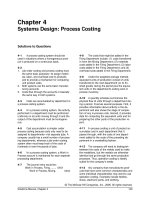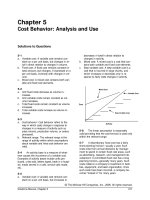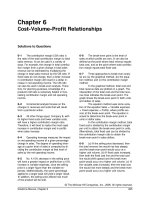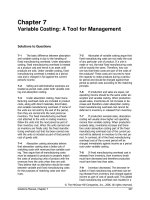Solutions to question managerial accounting ch05 cost behaivior analyssis and use
Bạn đang xem bản rút gọn của tài liệu. Xem và tải ngay bản đầy đủ của tài liệu tại đây (144.32 KB, 54 trang )
Chapter 5
Cost Behavior: Analysis and Use
Solutions to Questions
5-1
a. Variable cost: A variable cost remains constant on a per unit basis, but changes in total in direct relation to changes in volume.
b. Fixed cost: A fixed cost remains constant in
total amount, but changes, if expressed on a
per unit basis, inversely with changes in volume.
c. Mixed cost: A mixed cost contains both variable and fixed cost elements.
5-2
a. Unit fixed costs decrease as volume increases.
b. Unit variable costs remain constant as volume increases.
c. Total fixed costs remain constant as volume
increases.
d. Total variable costs increase as volume increases.
5-3
a. Cost behavior: Cost behavior refers to the
way in which costs change in response to
changes in a measure of activity such as
sales volume, production volume, or orders
processed.
b. Relevant range: The relevant range is the
range of activity within which assumptions
about variable and fixed cost behavior are
valid.
5-4
An activity base is a measure of whatever causes the incurrence of a variable cost.
Examples of activity bases include units produced, units sold, letters typed, beds in a hospital, meals served in a cafe, service calls made,
etc.
5-5
a. Variable cost: A variable cost remains constant on a per unit basis, but increases or
decreases in total in direct relation to
changes in activity.
b. Mixed cost: A mixed cost is a cost that contains both variable and fixed cost elements.
c. Step-variable cost: A step-variable cost is a
cost that is incurred in large chunks, and
which increases or decreases only in response to fairly wide changes in activity.
Mixed Cost
Variable Cost
Cost
Step-Variable Cost
Activity
5-6
The linear assumption is reasonably
valid providing that the cost formula is used only
within the relevant range.
5-7
A discretionary fixed cost has a fairly
short planning horizon—usually a year. Such
costs arise from annual decisions by management to spend in certain fixed cost areas, such
as advertising, research, and management development. A committed fixed cost has a long
planning horizon—generally many years. Such
costs relate to a company’s investment in facilities, equipment, and basic organization. Once
such costs have been incurred, a company becomes “locked in” for many years.
© The McGraw-Hill Companies, Inc., 2006. All rights reserved.
Solutions Manual, Chapter 5
211
5-8
a. Committed
b. Discretionary
c. Discretionary
d. Committed
e. Committed
f. Discretionary
5-9
Yes. As the anticipated level of activity
changes, the level of fixed costs needed to support operations will also change. Most fixed
costs are adjusted upward and downward in
large steps, rather than being absolutely fixed at
one level for all ranges of activity.
5-10 The high-low method uses only two
points to determine a cost formula. These two
points are likely to be less than typical since
they represent extremes of activity.
5-11 A mixed cost can be expressed in formula form as Y = a + bX. In cost analysis, the
“a” term represents the fixed cost element, and
the “b” term represents the variable cost element per unit of activity.
5-12 The term “least-squares regression”
means that the sum of the squares of the deviations from the plotted points on a graph to the
regression line is smaller than could be obtained
from any other line that could be fitted to the
data.
5-13 Ordinary single least-squares regression
analysis is used when a variable cost is a function of only a single factor. If a cost is a function
of more than one factor, multiple regression
analysis should be used to analyze the behavior
of the cost.
5-14 The contribution approach income
statement organizes costs by behavior, first deducting variable expenses to obtain contribution
margin, and then deducting fixed expenses to
obtain net operating income. The traditional approach organizes costs by function, such as production, selling, and administration. Within a
functional area, fixed and variable costs are intermingled.
5-15 The contribution margin is total sales
revenue less total variable expenses.
© The McGraw-Hill Companies, Inc., 2006. All rights reserved.
212
Managerial Accounting, 11th Edition
Exercise 5-1 (15 minutes)
1.
Cups of Coffee Served
in a Week
2,000
2,100
2,200
Fixed cost.................................... $1,200
Variable cost................................
440
Total cost .................................... $1,640
Cost per cup of coffee served *..... $0.820
$1,200
462
$1,662
$0.791
$1,200
484
$1,684
$0.765
* Total cost ÷ cups of coffee served in a week
2. The average cost of a cup of coffee declines as the number of cups of
coffee served increases because the fixed cost is spread over more cups
of coffee.
© The McGraw-Hill Companies, Inc., 2006. All rights reserved.
Solutions Manual, Chapter 5
213
Exercise 5-2 (45 minutes)
1.
High activity level (June) .......
Low activity level (July) .........
Change ................................
Units Shipped Shipping Expense
8
2
6
$2,700
1,200
$1,500
Variable cost element:
Change in expense $1,500
=
=$250 per unit.
Change in activity 6 units
Fixed cost element:
Shipping expense at high activity level ........................
Less variable cost element ($250 per unit × 8 units) ....
Total fixed cost .........................................................
$2,700
2,000
$ 700
The cost formula is $700 per month plus $250 per unit shipped or
Y = $700 + $250X,
where X is the number of units shipped.
2. a. See the scattergraph on the following page.
b. (Note: Students’ answers will vary due to the imprecision of this
method of estimating variable and fixed costs.)
Total cost at 5 units shipped per month [a point falling on the regression line in (a)] ...........................
Less fixed cost element (intersection of the Y axis) ....
Variable cost element ..............................................
$2,000
1,000
$1,000
$1,000 ÷ 5 units = $200 per unit.
The cost formula is $1,000 per month plus $200 per unit shipped or
Y = $1,000 + $200X.
where X is the number of units shipped.
© The McGraw-Hill Companies, Inc., 2006. All rights reserved.
214
Managerial Accounting, 11th Edition
Exercise 5-2 (continued)
2. a. The scattergraph would be:
$3,000
Y
Shipping Expense
$2,500
$2,000
$1,500
$1,000
$500
X
$0
0
2
4
6
8
10
Units Shipped
3. The cost of shipping units is likely to depend on the weight and volume
of the units and the distance traveled as well as on the number of units
shipped. In addition, higher cost shipping might be necessary in some
situations to meet a deadline.
© The McGraw-Hill Companies, Inc., 2006. All rights reserved.
Solutions Manual, Chapter 5
215
Exercise 5-3 (30 minutes)
1.
Month
January
February
March
April
May
June
July
Units
Shipped (X)
3
6
4
5
7
8
2
Shipping
Expense (Y)
$1,800
$2,300
$1,700
$2,000
$2,300
$2,700
$1,200
Statistical software or a spreadsheet application such as Excel can be
used to compute the slope and intercept of the least-squares regression
line for the above data. The results are:
Intercept (fixed cost) .................
Slope (variable cost per unit) ......
R2 .............................................
$911
$218
0.91
Therefore, the cost formula is $911 per month plus $218 per unit
shipped or
Y = $911 + $218X.
Note that the R2 is 0.91, which means that 91% of the variation in shipping costs is explained by the number of units shipped. This is a very
high R2 and indicates a good fit.
2.
Quick-and-dirty scattergraph method .......
High-low method ...................................
Least-squares regression method ............
Variable
Cost per
Unit
$200
$250
$218
Fixed Cost
per Month
$1,000
$700
$911
Note that the high-low method gives estimates that are quite different
from the estimates provided by least-squares regression.
© The McGraw-Hill Companies, Inc., 2006. All rights reserved.
216
Managerial Accounting, 11th Edition
Exercise 5-4 (20 minutes)
1.
High activity level (August) ...
Low activity level (October) ..
Change ...............................
OccupancyDays
2,406
124
2,282
Electrical
Costs
$5,148
1,588
$3,560
Variable cost = Change in cost ÷ Change in activity
= $3,560 ÷ 2,282 occupancy-days
= $1.56 per occupancy-day
Total cost (August) ..................................................... $5,148
Variable cost element
($1.56 per occupancy-day × 2,406 occupancy-days) ... 3,753
Fixed cost element ...................................................... $1,395
2. Electrical costs may reflect seasonal factors other than the just the
variation in occupancy days. For example, common areas such as the
reception area must be lighted for longer periods during the winter than
in the summer. This will result in seasonal fluctuations in the fixed electrical costs. Additionally, the fixed costs will be affected by the number
of days in a month. In other words, costs like the costs of lighting common areas are variable with respect to the number of days in the
month, but are fixed with respect to how many rooms are occupied during the month. Other, less systematic, factors may also affect electrical
costs such as the frugality of individual guests. Some guests will turn off
lights when they leave a room. Others will not.
© The McGraw-Hill Companies, Inc., 2006. All rights reserved.
Solutions Manual, Chapter 5
217
Exercise 5-5 (20 minutes)
1.
THE ALPINE HOUSE, INC.
Income Statement—Ski Department
For the Quarter Ended March 31
Sales......................................................................
Less variable expenses:
Cost of goods sold (200 pairs* × $450 per pair) .....
Selling expenses (200 pairs × $50 per pair) ............
Administrative expenses (20% × $10,000) .............
Contribution margin ................................................
Less fixed expenses:
Selling expenses
[$30,000 – (200 pairs × $50 per pair)] ................
Administrative expenses (80% × $10,000) .............
Net operating income ..............................................
$150,000
$90,000
10,000
2,000
20,000
8,000
102,000
48,000
28,000
$ 20,000
*$150,000 ÷ $750 per pair = 200 pairs.
2. Since 200 pairs of skis were sold and the contribution margin totaled
$48,000 for the quarter, the contribution of each pair of skis toward
covering fixed costs and toward earning of profits was $240 ($48,000 ÷
200 pairs = $240 per pair). Another way to compute the $240 is:
Selling price per pair ...........................
Less variable expenses:
Cost per pair....................................
Selling expenses ..............................
Administrative expenses
($2,000 ÷ 200 pairs) .....................
Contribution margin per pair................
$750
$450
50
10
510
$240
© The McGraw-Hill Companies, Inc., 2006. All rights reserved.
218
Managerial Accounting, 11th Edition
Exercise 5-6 (20 minutes)
1. The company’s variable cost per unit would be:
$180,000
=$6 per unit.
30,000 units
In accordance with the behavior of variable and fixed costs, the completed schedule would be:
Units produced and sold
30,000
40,000
50,000
Total costs:
Variable costs .............. $180,000
Fixed costs.................. 300,000
Total costs .................. $480,000
Cost per unit:
Variable cost ...............
$ 6.00
Fixed cost ...................
10.00
Total cost per unit........
$16.00
$240,000 $300,000
300,000 300,000
$540,000 $600,000
$ 6.00
7.50
$13.50
$ 6.00
6.00
$12.00
2. The company’s income statement in the contribution format would be:
Sales (45,000 units × $16 per unit) .......................... $720,000
Less variable expenses (45,000 units × $6 per unit) .. 270,000
Contribution margin ................................................ 450,000
Less fixed expense.................................................. 300,000
Net operating income .............................................. $150,000
© The McGraw-Hill Companies, Inc., 2006. All rights reserved.
Solutions Manual, Chapter 5
219
Exercise 5-7 (20 minutes)
1. a. Difference in cost:
Monthly operating costs at 80% occupancy:
450 beds × 80% = 360 beds;
360 beds × 30 days × $32 per bed-day .................... $345,600
Monthly operating costs at 60% occupancy (given) ......
326,700
Difference in cost....................................................... $ 18,900
Difference in activity:
80% occupancy (450 beds × 80% × 30 days)...........
60% occupancy (450 beds × 60% × 30 days)...........
Difference in activity ..................................................
10,800
8,100
2,700
Change in cost
$18,900
=
=$7 per bed-day.
Change in activity
2,700 bed-days
b. Monthly operating costs at 80% occupancy (above) ......... $345,600
Less variable costs:
360 beds × 30 days × $7 per bed-day .......................... 75,600
Fixed operating costs per month ..................................... $270,000
2. 450 beds × 70% = 315 beds occupied.
Fixed costs ...............................................................
Variable costs: 315 beds × 30 days × $7 per bed-day..
Total expected costs..................................................
$270,000
66,150
$336,150
© The McGraw-Hill Companies, Inc., 2006. All rights reserved.
220
Managerial Accounting, 11th Edition
Exercise 5-8 (20 minutes)
1.
Custodial
Guest- Supplies
Days Expense
High activity level (July).................. 12,000
Low activity level (March) ............... 4,000
Change ......................................... 8,000
$13,500
7,500
$ 6,000
Variable cost element:
Change in expense
$6,000
=
=$0.75 per guest-day
Change in activity 8,000 guest-days
Fixed cost element:
Custodial supplies expense at high activity level....... $13,500
Less variable cost element:
12,000 guest-days × $0.75 per guest-day.............
9,000
Total fixed cost ..................................................... $ 4,500
The cost formula is $4,500 per month plus $0.75 per guest-day or
Y = $4,500 + $0.75 X.
2. Custodial supplies expense for 11,000 guest-days:
Variable cost:
11,000 guest-days × $0.75 per guest-day.... $ 8,250
Fixed cost....................................................
4,500
Total cost .................................................... $12,750
© The McGraw-Hill Companies, Inc., 2006. All rights reserved.
Solutions Manual, Chapter 5
221
Exercise 5-9 (30 minutes)
1. The scattergraph appears below:
$16,000
Y
Custodial Supplies Cost
$14,000
$12,000
$10,000
$8,000
$6,000
$4,000
$2,000
X
$0
0
2,000
4,000
6,000
8,000 10,000 12,000 14,000
Guest-Days
© The McGraw-Hill Companies, Inc., 2006. All rights reserved.
222
Managerial Accounting, 11th Edition
Exercise 5-9 (continued)
2. (Note: Students’ answers will vary considerably due to the inherent lack
of precision and subjectivity of the quick-and-dirty method.)
Total costs at 7,500 guest-days per month [a point falling on the line in (1)]............................................... $9,750
Less fixed cost element (intersection of the Y axis)........ 3,750
Variable cost element .................................................. $6,000
$6,000 ÷ 7,500 guest-days = $0.80 per guest-day.
The cost formula is therefore $3,750 per month, plus $0.80 per guestday or
Y = $3,750 + $0.80X,
where X is the number of guest-days.
3. The high-low method would not provide an accurate cost formula in this
situation since a line drawn through the high and low points would have
a slope that is too flat and would be placed too high, cutting the cost
axis at about $4,500 per month. The high and low points are not representative of all of the data in this situation.
© The McGraw-Hill Companies, Inc., 2006. All rights reserved.
Solutions Manual, Chapter 5
223
Exercise 5-10 (30 minutes)
1. The scattergraph appears below:
$60,000
Y
Processing Cost
$50,000
$40,000
$30,000
$20,000
$10,000
$0
0
2,000
4,000
6,000
X
8,000 10,000 12,000 14,000
Units Produced
© The McGraw-Hill Companies, Inc., 2006. All rights reserved.
224
Managerial Accounting, 11th Edition
Exercise 5-10 (continued)
2. (Students’ answers will vary considerably due to the inherent imprecision of the quick-and-dirty method.)
The approximate monthly fixed cost is $30,000—the point where the
line intersects the cost axis. The variable cost per unit processed can be
estimated using the 8,000-unit level of activity, which falls on the line:
Total cost at an 8,000-unit level of activity .............. $46,000
Less fixed costs.....................................................
30,000
Variable costs at an 8,000-unit level of activity ........ $16,000
$16,000 ÷ 8,000 units = $2 per unit.
Therefore, the cost formula is $30,000 per month plus $2 per unit processed.
Observe from the scattergraph that if the company used the high-low
method to determine the slope of the regression line, the line would be
too steep. This would result in underestimating fixed costs and overestimating the variable cost per unit.
© The McGraw-Hill Companies, Inc., 2006. All rights reserved.
Solutions Manual, Chapter 5
225
Exercise 5-11 (20 minutes)
1.
High level of activity...........................
Low level of activity............................
Change .............................................
Kilometers Total Annual
Driven
Cost*
105,000
70,000
35,000
$11,970
9,380
$ 2,590
* 105,000 kilometers × $0.114 per kilometer = $11,970
70,000 kilometers × $0.134 per kilometer = $9,380
Variable cost per kilometer:
Change in cost
$2,590
=
=$0.074 per kilometer.
Change in activity 35,000 kilometers
Fixed cost per year:
Total cost at 105,000 kilometers .......................
Less variable portion:
105,000 kilometers × $0.074 per kilometer ....
Fixed cost per year..........................................
$11,970
7,770
$ 4,200
2. Y = $4,200 + $0.074X
3. Fixed cost...........................................................
Variable cost:
80,000 kilometers × $0.074 per kilometer ..........
Total annual cost.................................................
$ 4,200
5,920
$10,120
© The McGraw-Hill Companies, Inc., 2006. All rights reserved.
226
Managerial Accounting, 11th Edition
Exercise 5-12 (30 minutes)
1.
Week
1
2
3
4
5
6
Units (X) Total Etching Cost (Y)
4
3
8
6
7
2
18
17
25
20
24
16
Statistical software or a spreadsheet application such as Excel can be
used to compute the slope and intercept of the least-squares regression
line for the above data. The results are:
Intercept (fixed cost) ................. SFr 12.32
Slope (variable cost per unit) ...... SFr 1.54
0.93
R2 .............................................
Therefore, the cost formula is SFr 12.32 per month plus SFr 1.54 per
unit etched or
Y = SFr 12.32 + SFr 1.54.
Note that the R2 is 0.93, which means that 93% of the variation in etching costs is explained by the number of units etched. This is a very high
R2 and indicates a good fit.
2. Y = SFr 12.32 + SFr 1.54X
3. Total expected etching cost if 5 units are processed:
Variable cost: 5 units × SFr 1.54 per unit ... SFr 7.70
Fixed cost ................................................
12.32
Total expected cost .................................. SFr 20.02
© The McGraw-Hill Companies, Inc., 2006. All rights reserved.
Solutions Manual, Chapter 5
227
Problem 5-13 (45 minutes)
1. Cost of goods sold ................... Variable
Advertising expense ................. Fixed
Shipping expense..................... Mixed
Salaries and commissions ......... Mixed
Insurance expense ................... Fixed
Depreciation expense ............... Fixed
2. Analysis of the mixed expenses:
Shipping
Expense
Units
High level of activity ........ 5,000
Low level of activity......... 4,000
Change .......................... 1,000
A$38,000
34,000
A$ 4,000
Salaries and
Commission
Expense
A$90,000
78,000
A$12,000
Variable cost element:
Variable rate=
Change in cost
Change in activity
Shipping expense:
A$4,000
=A$4 per unit.
1,000 units
Salaries and Commission Expense:
A$12,000
=A$12 per unit.
1,000 units
Fixed cost element:
Cost at high level of activity ....
Less variable cost element:
5,000 units × A$4 per unit....
5,000 units × A$12 per unit..
Fixed cost element .................
Shipping
Expense
A$38,000
20,000
A$18,000
Salaries and
Commission
Expense
A$90,000
60,000
A$30,000
© The McGraw-Hill Companies, Inc., 2006. All rights reserved.
228
Managerial Accounting, 11th Edition
Problem 5-13 (continued)
The cost formulas are:
Shipping expense:
A$18,000 per month plus A$4 per unit
or
Y = A$18,000 + A$4 X.
Salaries and Comm. expense:
A$30,000 per month plus A$12 per unit
or
Y = A$30,000 + A$12 X.
3.
Morrisey & Brown, Ltd.
Income Statement
For the Month Ended September 30
Sales revenue
(5,000 units × A$100 per unit) ..................
A$500,000
Less variable expenses:
Cost of goods sold
(5,000 units × A$60 per unit) ................ A$300,000
Shipping expense
(5,000 units × A$4 per unit) ...................
20,000
Salaries and commissions expense
(5,000 units × A$12 per unit) .................
60,000
380,000
Contribution margin ....................................
120,000
Less fixed expenses:
Advertising expense..................................
21,000
Shipping expense .....................................
18,000
Salaries and commissions expense.............
30,000
Insurance expense ...................................
6,000
90,000
Depreciation expense................................
15,000
Net operating income ..................................
A$ 30,000
© The McGraw-Hill Companies, Inc., 2006. All rights reserved.
Solutions Manual, Chapter 5
229
Problem 5-14 (45 minutes)
1.
MARWICK’S PIANOS, INC.
Income Statement
For the Month of August
Sales (40 pianos × $3,125 per piano) ...............
$125,000
Less cost of goods sold
(40 pianos × $2,450 per piano) .....................
98,000
Gross margin ..................................................
27,000
Less operating expenses:
Selling expenses:
Advertising ................................................ $ 700
Sales salaries and commissions
[$950 + (8% × $125,000)] ...................... 10,950
Delivery of pianos
(40 pianos × $30 per piano) ....................
1,200
Utilities .....................................................
350
Depreciation of sales facilities .....................
800
Total selling expenses ................................... 14,000
Administrative expenses:
Executive salaries.......................................
2,500
Insurance..................................................
400
Clerical
[$1,000 + (40 pianos × $20 per piano)]....
1,800
Depreciation of office equipment.................
300
Total administrative expenses ........................
5,000
Total operating expenses .................................
19,000
Net operating income ......................................
$ 8,000
© The McGraw-Hill Companies, Inc., 2006. All rights reserved.
230
Managerial Accounting, 11th Edition
Problem 5-14 (continued)
2.
MARWICK’S PIANOS, INC.
Income Statement
For the Month of August
Total
Sales (40 pianos × $3,125 per piano) ................... $125,000
Less variable expenses:
Cost of goods sold
(40 pianos × $2,450 per piano) ......................
98,000
Sales commissions (8% × $125,000) .................
10,000
Delivery of pianos (40 pianos × $30 per piano)...
1,200
Clerical (40 pianos × $20 per piano) ..................
800
Total variable expenses ....................................... 110,000
Contribution margin ............................................
15,000
Less fixed expenses:
Advertising.......................................................
700
Sales salaries ...................................................
950
Utilities ............................................................
350
Depreciation of sales facilities ............................
800
Executive salaries .............................................
2,500
Insurance ........................................................
400
Clerical ............................................................
1,000
Depreciation of office equipment .......................
300
Total fixed expenses............................................
7,000
Net operating income .......................................... $ 8,000
Per
Piano
$3,125
2,450
250
30
20
2,750
$ 375
3. Fixed costs remain constant in total but vary on a per unit basis inversely with changes in the activity level. As the activity level increases,
for example, the fixed costs will decrease on a per unit basis. Showing
fixed costs on a per unit basis on the income statement might mislead
management into thinking that the fixed costs behave in the same way
as the variable costs. That is, management might be misled into thinking that the per unit fixed costs would be the same regardless of how
many pianos were sold during the month. For this reason, fixed costs
generally are shown only in totals on a contribution format income
statement.
© The McGraw-Hill Companies, Inc., 2006. All rights reserved.
Solutions Manual, Chapter 5
231
Problem 5-15 (45 minutes)
1.
Term
Fall, last year ...........
Winter, last year.......
Summer, last year ....
Fall, this year ...........
Winter, this year.......
Number of Sections
Offered (X)
4
6
2
5
3
Total Cost (Y)
$10,000
$14,000
$7,000
$13,000
$9,500
A spreadsheet application such as Excel or a statistical software package
can be used to compute the slope and intercept of the least-squares regression line for the above data. The results are:
Intercept (fixed cost) .................
Slope (variable cost per unit) ......
R2 .............................................
$3,700
$1,750
0.95
Therefore, the variable cost is $1,750 per section and the fixed cost is
$3,700 per term.
Note that the R2 is 0.95, which means that 95% of the variation in cost
is explained by the number of sections. This is a very high R2 and indicates a very good fit.
2. Y = $3,700 + $1,750X
3. Expected total cost would be:
Fixed cost........................................................ $ 3,700
Variable cost (8 sections × $1,750 per section)... 14,000
Total cost ........................................................ $17,700
The problem with using the cost formula from (2) to derive total cost is
that an activity level of 8 sections may lie outside the relevant range—
the range of activity within which the fixed cost is approximately $3,700
per term and the variable cost is approximately $1,750 per section offered. These approximations appear to be reasonably accurate within
the range of 2 to 6 sections, but they may be invalid outside this range.
© The McGraw-Hill Companies, Inc., 2006. All rights reserved.
232
Managerial Accounting, 11th Edition
Problem 5-15 (continued)
4.
Y
$16,000
$14,000
Total Cost
$12,000
$10,000
$8,000
$6,000
$4,000
$2,000
$0
0
1
2
3
4
5
6
X
7
Number of Sections
© The McGraw-Hill Companies, Inc., 2006. All rights reserved.
Solutions Manual, Chapter 5
233
Problem 5-16 (30 minutes)
1. a. 3
b. 6
c. 11
d. 1
e. 4
f. 10
g. 2
h. 7
i. 9
2. Without a knowledge of the underlying cost behavior patterns, it would
be difficult if not impossible for a manager to properly analyze the firm’s
cost structure. The reason is that all costs don’t behave in the same
way. One cost might move in one direction as a result of a particular action, and another cost might move in an opposite direction. Unless the
behavior pattern of each cost is clearly understood, the impact of a
firm’s activities on its costs will not be known until after the activity has
occurred.
© The McGraw-Hill Companies, Inc., 2006. All rights reserved.
234
Managerial Accounting, 11th Edition
Problem 5-17 (45 minutes)
1. High-low method:
High level of activity ....
Low level of activity.....
Change ......................
Variable rate:
Number of Utilities Cost
Scans
150
60
90
$4,000
2,200
$1,800
Change in cost
$1,800
=
=$20 per scan
Change in activity 90 scans
Fixed cost: Total cost at high level of activity.............
Less variable element:
150 scans × $20 per scan ....................
Fixed cost element .................................
$4,000
3,000
$1,000
Therefore, the cost formula is: Y = $1,000 + $20X.
2. Scattergraph method (see the scattergraph on the following page):
(Note: Students’ answers will vary due to the inherent imprecision of the
quick-and-dirty method.)
The line intersects the cost axis at about $1,200. The variable cost can
be estimated as follows:
Total cost at 100 scans (a point that falls on the line)....
Less the fixed cost element.........................................
Variable cost element (total) .......................................
$3,000
1,200
$1,800
$1,800 ÷ 100 scans = $18 per scan.
Therefore, the cost formula is: Y = $1,200 + $18X.
© The McGraw-Hill Companies, Inc., 2006. All rights reserved.
Solutions Manual, Chapter 5
235
